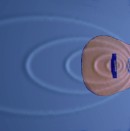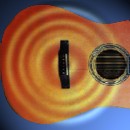|
The top of a guitar is made from a thin sheet of flexible wood which is set in motion by the vibrating strings attached to the bridge in the center of the top. |
 |
If the strings were perpendicular to the top, the vibration would be even and would spread out uniformly from the bridge much as a pool of water reacts when we drop a rock in it. |
| In reality, the strings approach from the side causing the top to react more like we had skipped a rock across our pool of water. (Astute viewers will know that the ripples on a pool of water will always be circular. We're actually looking at interference patterns which have a much more complex explanation from a physics point of view. The density of the wood, variations in compression ahead of and behind the bridge, lateral stress forces, placement of braces and other factors all contribute to the behavior of these interference patterns. Though not entirely accurate, the water analogy is easy to visualize.) |  |
 |
Essentially, the top behaves more as if waves were moving across it. This explains why the soundhole directly in front of the bridge doesn't adversely effect the sound of the instrument. Most of the vibration is behind the bridge. |
| If we install a JLD Bridge System in the guitar, the effect is to dramatically stiffen the top in the center where the bridge is mounted. The top vibrations will tend to move from a place of greater resistance (the stiffened center of the top) to a place of lesser resistance (the flexible edges of the top). This offsets much of the bias towards keeping the sound locked behind the bridge. |  |
| The JLD Bridge System allows much more vibration to be channelled through the entire top. This translates to almost twice the amount of top surface being used to amplify your guitar. This means more volume, sustain and projection. |

|
JLD Guitar Research & Development PO Box 5764 Roswell, NM 1-888-696-1998 1-505-622-3694 - Don Kendall email: orders@jldguitar.com |